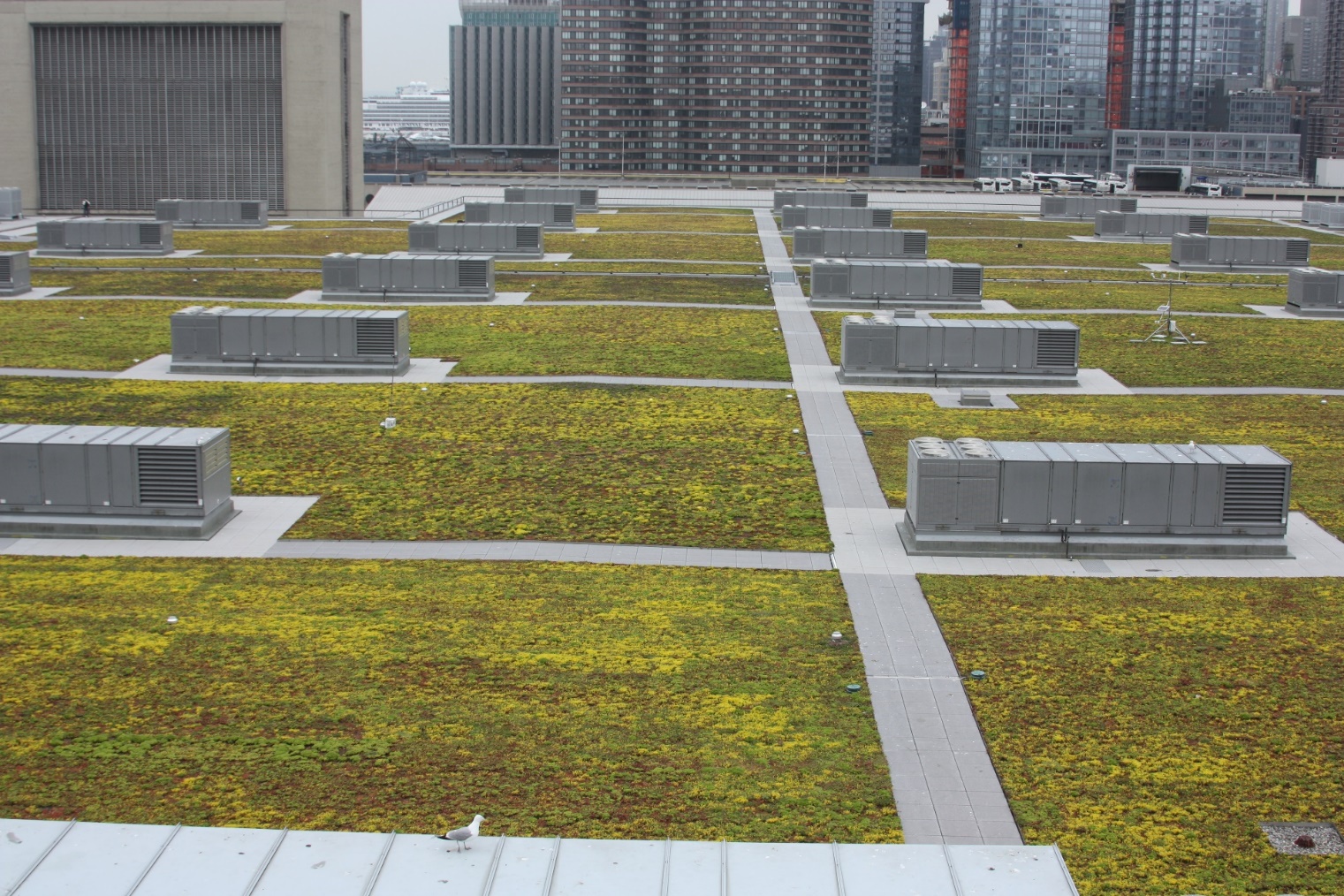This CE Center article is no longer eligible for receiving credits.
Asphaltic-based low-slope roofing is one of the oldest low-slope roofing technologies; appropriately, it remains a leader in construction segments such as healthcare, education, hospitality, and mixed use. Asphaltic-based roof systems are durable, have a long history of proven performance, and their redundancy provides owners peace of mind. The benefits of asphaltic-based roof systems include durability and redundancy. When used in hybrid systems that combine modified plies with a single-ply cap sheet, the result is a roof system that offers the best of both technologies.
A Short History of Low-Slope Asphaltic Roofing
All asphaltic roof systems start with the same base raw material. The terms bitumen and asphalt are often used interchangeably within the construction industry: asphalt is the most common reference in the U.S., while bitumen is the preferred term internationally. Bitumen is an immensely viscous material that, depending on its exact composition, can be a sticky, black liquid or an apparently solid mass. Bitumen can be found naturally or it can be a by-product from refining crude oil. Pitch Lake in Trinidad has the world’s largest known deposit of natural bitumen, estimated to contain at least 10 million tons of material.

Photo courtesy GAF/Siplast
Natural bitumen at Pitch Lake in Trinidad.
The long history of people and bitumen
The qualities of bitumen have been known and used for human construction projects since ancient times. The earliest estimated use of bitumen dates back 40,000 years to the paleolithic period, where bitumen was used to adhere handles onto primitive stone tools.1 The use of natural bitumen for waterproofing, as well as an adhesive, dates at least to the fifth millennium BC, where it was used in crop storage baskets discovered in Mehrgarh, from the Indus Valley civilization.2 By the third millennium BC, refined rock asphalt was in use throughout the region of present-day India and was used to waterproof the Great Bath in Mohenjo-daro.3 In the ancient Near East, the Sumerians used natural bitumen deposits for mortar between bricks and stones, to adhere parts of carvings into place, and for ship caulking and waterproofing.4
Bitumen in modern times
Documentation of modern low-slope roofs using layers of bitumen and ply sheets to provide waterproofing goes back to at least the 1890s. Multi-layer asphaltic or bitumen roof systems remained the dominant roof assembly of choice until the 1970s and they have continued to endure due to their exceptional hardiness and multiple layers of protection. However, by 2022, asphaltic systems had fallen in popularity: making up about 20 percent of the commercial roofing market. Despite this decline, bitumen or asphaltic roofs are still relied upon today for projects due to their remarkable durability. The redundancy achieved by multiple layers of bitumen provides resilient protection from damage due to heavy foot traffic and during storms and wind events. Bitumen systems can be elastomeric, have built-in puncture resistance, and are compatible with a variety of substrates and conditions. Additionally, bitumen roof systems create an effective, simple, and practical water control system. If the top layer is damaged, the layers below will continue to protect the building from water intrusion.
Not only is a bitumen roof system a time-tested technology with proven performance and redundancy, but modern advances have increased installation options, surfacing variety, and detailing and repair advantages.
Meet the Family – Types of Low-Slope Asphaltic Roofing
BUR
The original asphaltic roof system for low-slope roofs is referred to as a built-up roof (BUR) system. BUR roof systems have been used for more than one hundred years in the U.S. BUR roof systems are made up of multiple, alternating layers of reinforcing ply sheets and asphalt, providing multiple layers of protection. BUR systems remain in use today because of the excellent protection they provide.
The core of the BUR system is assembled using a shingling system of alternating layers of plies and liquid oxidized asphalt, embedding each ply into a layer of asphalt and ensuring substantial overlap with the previous ply. Historically, rags, paper, or asbestos were used as the reinforcing plies. Thanks to technology advancements, the plies are generally asphalt-impregnated fiberglass felts, fabrics or mats. Fiberglass felt plies or glass plies contribute to the fire-resistance of the roof system.
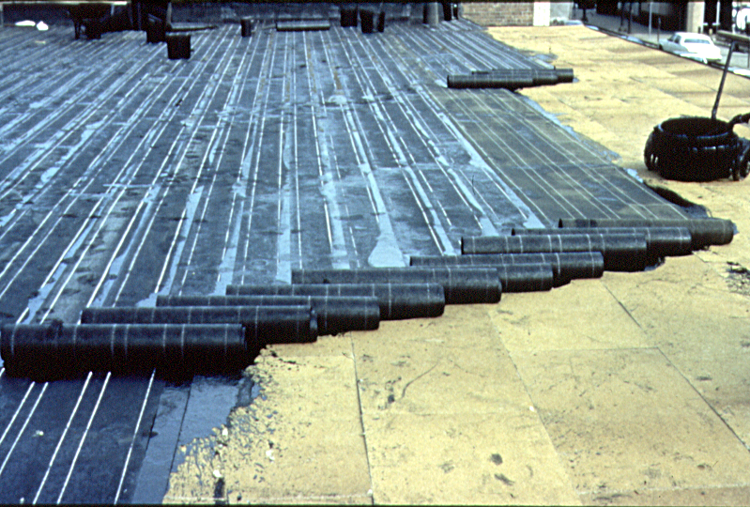
Photo courtesy GAF/Siplast
Installation of a BUR roof system.
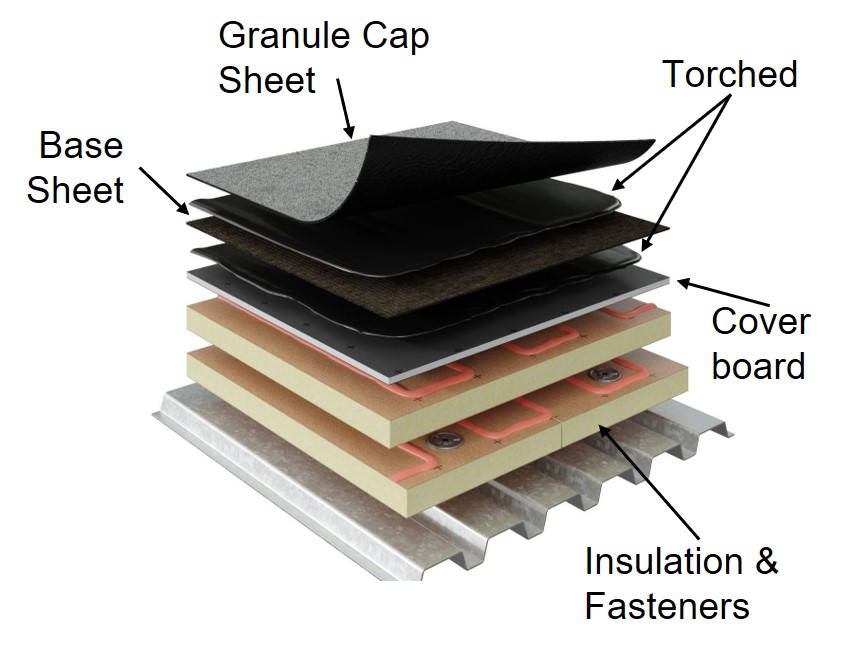
Image courtesy GAF/Siplast
Figure 3. Diagram of layers in a BUR roof system.
Installers traditionally rely on hot mopping of the asphalt requiring kettles, either placed on the roof or on the ground onsite. Advances in manufacturing have created alternative options such as cold-applied adhesive solutions instead of hot mopping asphalt and kettles. Cold-applied adhesives have temperature installation limits, but they can reduce the challenge of keeping an asphalt kettle hot enough during cooler weather.
The layering process is repeated on the roof with the application of asphalt or cold-applied adhesive, followed by the installation of additional plies until the desired number of plies is achieved. The multiple plies, when saturated in asphalt or cold-applied adhesive, create a barrier that provides additional resistance to water intrusion. The complete roof assembly typically ranges from 2 to 5 plies. This installation method can be labor intensive and requires quality workmanship to be successful. The system is then surfaced with either a mineral-surfaced cap sheet or with a flood coat of asphalt and mineral aggregate or gravel, a liquid applied coating, or, historically, slag.
Benefits of BUR
Built up roofing owes its popularity to the number of benefits it provides. It is a time-tested technology, with more than 100 years of history. These roofs provide many layers of protection, so that if the top layer becomes damaged, the additional layers below will continue to protect the building from water intrusion. BUR is, by design, redundant. BUR system materials remain relatively inexpensive and offer excellent fire resistance. However, BUR installation is more labor intensive than other low-slope roofing choices.
Because of its proven performance and resilience, BUR systems may be eligible for guarantees or warranties exceeding 20 years, depending on the materials used and the system installed. Modern BUR manufacturers also offer reflective cap sheets or granules. These cap sheets are available to help reflect the sun's rays away from the building, which can assist in maintaining internal temperatures.
Developments in roofing after World War II
Roofing, and the construction industry in general, experienced dramatic shifts in materials after World War II. This shift in both technology and availability changed how buildings were built. Roofs became noticeably flatter as lightweight steel construction supplanted the use of concrete and wood framing. As roofs became flatter, more equipment moved to the roof and the amount of foot traffic on the roof increased. The greater use of steel created buildings that flexed and moved more, requiring materials capable of accommodating the movement without failures. Additionally, the efforts from the war produced new types of polymers that were used in automotive and aeronautic applications that also found their way into roofing.
At the same time, the quality of BUR materials dropped dramatically. As a result, the industry developed a “new” bitumen that utilized polymers added to a bituminous base. These modified bitumen blends were used to create new membranes with the redundancy and durability of traditional BUR, but with additional properties from the rubber or plastic modifiers. The new formulas were able to accommodate the movement and have increased durability as the modified bitumen had a higher softening point and more elongation.
Creating modified bitumen blends
Modified bitumen used in roof materials is produced by blending together raw bitumen, filler, and polymer which are then layered with reinforcement to create a modified bitumen roll. Not all bitumen blends are the same. The quality of the final material is highly dependent on the quality of raw materials used, the manufacturer’s formulation, and the blending process. It is critical to be aware that there are different asphalt sources of varying quality and different types and quantities of polymer and fillers that can alter the final properties and durability of a material.
Bitumen forms the foundation of a good quality blend. Not all bitumen is receptive to modification and blending with the other components of the final material. Additionally, lower quality bitumen results in poor performance and premature aging of the entire product. Therefore, a manufacturer’s asphalt source is extremely important.
While fillers are the lowest cost material used, they have important roles to play in the final formulation. Filler is the material that stabilizes the blend and provides the finished product with many of its engineered properties. Fillers are typically mineral-based. They are used to stabilize the formula, bolster fire resistance, and increase ultra-violet light (UV) and weathering resistance. For example, the addition of carbon and graphite can increase fire performance. Limestone and basalt can decrease the cost of the formula and aid in absorbing excess oil. Waxes and tackifying oils are added to increase self-adhesive properties of the formula. Most modified bitumen formulas contain between 25 percent and 35 percent filler. If a formulation has too much filler, more than 35 percent in filler additives, the final blend degrades.
Polymers are the most expensive element of a modified bitumen blend. There are three common polymers used to modify asphalt today: SBS (styrene butadiene styrene), APP (atactic polypropylene), and IPP (isotactic polypropylene). We’re going to focus on the two most common polymer blends currently used in roofing: APP and SBS.
APP
APP is short for Atactic Polypropylene. It is a plastic-type polymer that imparts rigidity to the final material. A good APP-modified bitumen material will typically have 20-30 percent APP in the final formulation. APP modified bitumen materials have a higher softening temperature and are harder or have a higher durometer than SBS modified bitumens.
SBS
SBS, or Styrene-Butadiene-Styrene, is a rubber-type polymer that comprises roughly 10 to 13 percent of the total blend. An SBS-modified bitumen blend is a softer, more malleable final product than an APP blend. This additive allows the blended SBS to achieve greater elongation than other asphaltic systems.
Reinforcing scrim
Reinforcing scrim acts as a carrier for the modified bitumen. The scrim is embedded within the sheet and provides dimensional stability for the roll, improves fastener retention, and increases puncture resistance. There are three primary types of reinforcing scrim: fiberglass, polyester and composite or hybrid mats.
The type of scrim or reinforcement will influence different properties of the material. Fiberglass reinforcement is more fire resistant and provides dimensional stability while polyester reinforcement is more puncture resistant and has better elongation and tear resistance.
The modified bitumen sheets can be specified based on the type of reinforcement using different ASTM specification numbers. In the case of SBS rolls, ASTM D 6163 denotes a fiberglass reinforcement, ASTM D 6164 is for polyester reinforcement and ASTM E6162 is the specification for SBS sheets with a combination or hybrid reinforcement. In addition to specifying the ASTM specification number, it is valuable to also reference the Type and Grade of the material. The Type further indicates the mass and physical properties of the sheet: Type II materials have a larger net mass, peak load, and tear strength than Type I. The Grade indicates the surfacing of the sheet, either G for granule or S for smooth.
Summary
All of the components of a modified bitumen sheet - the bitumen, filler, and polymer - come together through a blending process. Adding a polymer changes the dispersal and consistency of all the products throughout the blend, making the blending protocol incredibly important. The blending time and temperature can greatly affect the dispersal and consistency of the filler and polymer within the bitumen matrix, changing the properties of the final material. The modified bitumen is then extruded into rolls with the reinforcement of choice to make the final roll used on a building.
Installation and Application Options
Commercial asphalt roofing systems are multi-ply systems consisting of two or more waterproofing layers. This redundancy provides building owners with durable protection for their building. Beyond the material properties, asphaltic or bitumen roof systems are adaptable and can be installed using various methods with multiple detailing options and surfacing varieties.
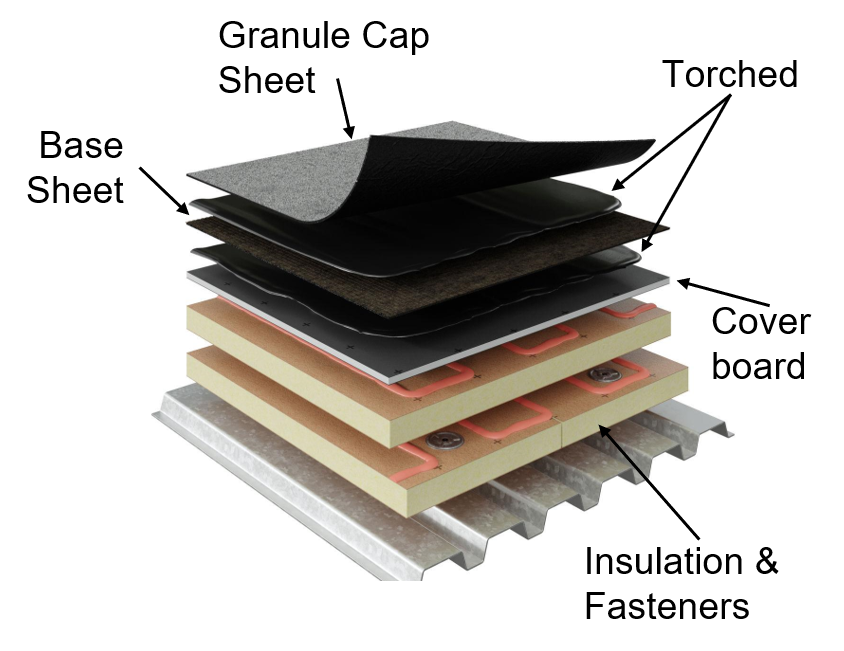
Image courtesy GAF/Siplast
Figure 5. Installed image of a modified bitumen system.
Installation options
Modified bitumen systems consist of at least two layers: a base sheet and a cap sheet. An additional base sheet may be mechanically attached to the roof deck in cases where the application requires. Both SBS and APP sheets can be torch applied, cold applied or self-adhered. However, APP is most commonly installed by torching due to the high temperatures required to get the material to flux or melt; cold-applied and self-adhered options for APP may not be readily available. Additionally, SBS has the ability to be hot mopped. This list of installation methods may not be exhaustive of all options available on the market as the industry is always changing and new products are introduced and discontinued (see Figure 5). It is not necessary for both layers of a modified bitumen system to be installed in the same manner.
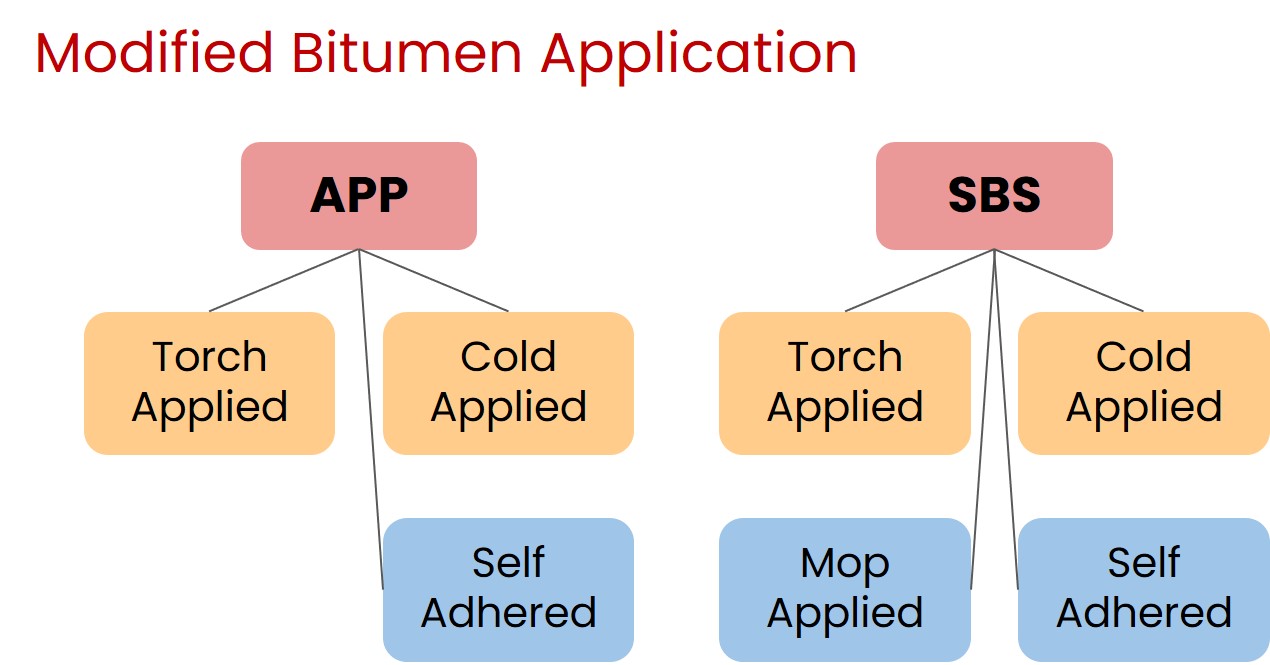
Image courtesy GAF/Siplast
Figure 6. Installation options for modified bitumen systems.
Both APP and SBS modified rolls can be installed using a torch method. Torch application uses an open-flamed torch to heat the back side of the sheet to flux, or the point of softening the modified bitumen so that it will adhere to the substrate below as it cools. It is important to note that APP fluxes at a much higher temperature than SBS, so crews who are used to torching one style of sheet may initially struggle to torch the other style. Because of the lower temperatures at which SBS membranes soften, the seams of the membrane can be sealed using a welder similar to the method to seal seams of a single-ply membrane.
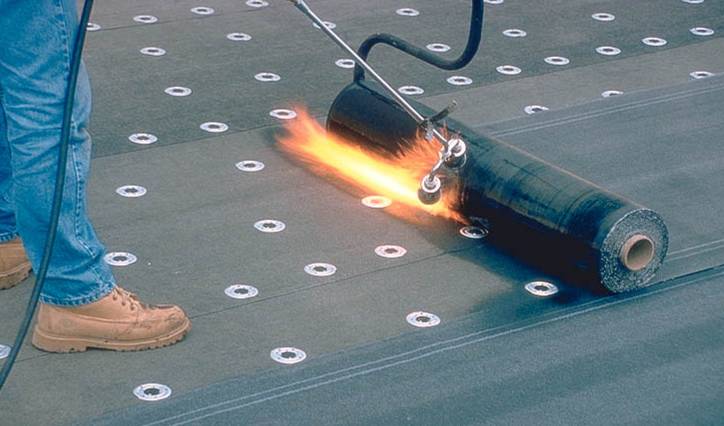
Photo courtesy GAF/Siplast
Installation of a modified bitumen roll using torch application.

Photo courtesy GAF/Siplast
Sealing the seams of an SBS membrane with a welder, similar to the method used to seal seams of a single-ply membrane.
The other hot method for applying asphaltic roof systems is called hot-mopping. This is the method used for BUR roofing but can be used for SBS systems as well. Hot mopping involves melting blocks of asphalt in a large kettle and spreading the melted asphalt on the roof with mops. In addition to being an adhesive, this method can provide additional redundancy to the SBS system as you have a thicker sheet that already provides waterproofing being embedded in a layer of asphalt which will act as its own waterproofing component.
SBS can also be installed using a cold-applied adhesive. For this method, a solvent-based or solvent-free liquid adhesive is applied to the roof surface or previously laid membrane and spread evenly using a tool such as a notched squeegee. The modified bitumen sheet is then rolled into the adhesive. This option is good for when asphaltic fumes, open flames, and kettles that can accompany hot-applied roofing are not permissible.
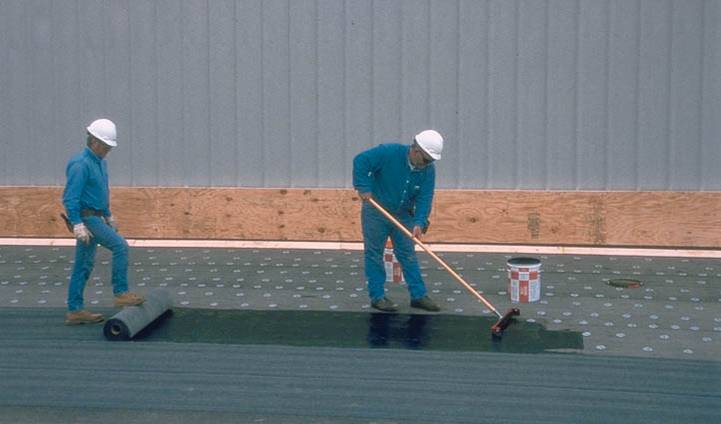
Photo courtesy GAF/Siplast
SBS modified bitumen rolls installed using a cold-applied adhesive.
Finally, self-adhered modified bitumen membranes are available, both for SBS and a few APP systems. A self-adhered membrane is installed by removing a release film off the back of an already rolled out membrane. The membrane is then rolled to ensure it adheres to the substrate below. This method can increase the speed of installation over other traditional methods. Self-adhered membranes do not produce unpleasant odors, fumes, or heat, an important factor installing on an occupied building.
Surfacing variety
Asphaltic assemblies need a top surface to provide protection from UV, excessive surface temperatures, to provide fire protection, and to provide puncture and roof traffic resistance. There are many options available to designers and owners depending on the desired aesthetic and roof use. These options include a flood coat of asphalt and mineral aggregate or gravel, a mineral-surfaced cap sheet, an elastomeric coating, or even a traditional fleeceback single-ply membrane.
The traditional method to complete a bitumen roof such as BUR is a flood coating of asphalt with embedded gravel. The gravel layer protects from UV degradation, roof traffic, storm damage, and wind debris. For this option to be successful, the roof structure below must be designed and built to accommodate the anticipated additional weight of the gravel.
One of the most common ways to surface an asphaltic roof assembly is with a mineral surfaced or granulated cap sheet. This sheet employs a modified sheet that is thicker and has the granules already factory applied to the sheet. This cap sheet provides UV protection and surfacing to protect from traffic. Bright white granules with a high solar reflective index (SRI) for projects that need to meet specific reflectivity requirements are also available.
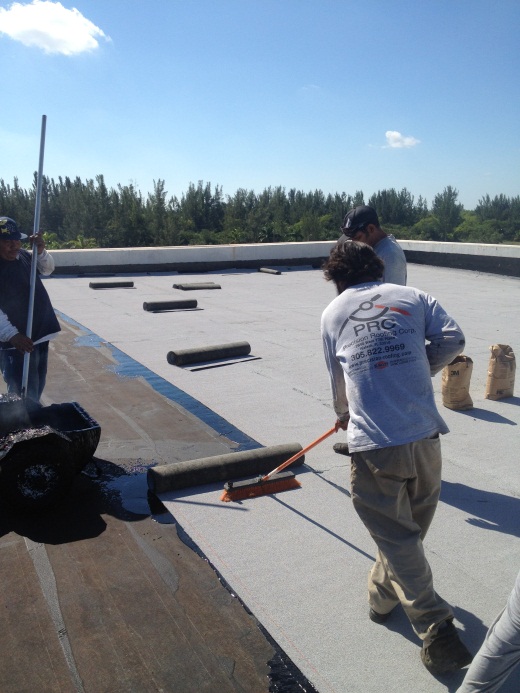
Photo courtesy GAF/Siplast
Application of a cap sheet.
Some modified bitumen assemblies can also be surfaced with a coating. The coating can be a squeegee-applied glaze coat of Type 1 asphalt, an asphaltic-based clay emulsion coating or any number of elastomeric coatings such as silicone, acrylics or urethanes. The elastomeric coatings may not be as strong against debris or roof traffic, but there are multiple options with high SRI values.
Finally, a fleece-backed thermoplastic membrane can be the surfacing or cap for a modified system. These membranes can have high SRI values, are resistant to ponding water, are easy to repair and maintain, and may offer more resistance to certain chemicals. This type of “hybrid” system provides the redundancy of a modified system with the benefits of a thermoplastic membrane.
Detailing and repair
As with the vast majority of roof systems, transition details can be done with materials of a technology similar to the roof material itself. For example, an SBS system can be specified to use an SBS flashing sheet with a granule surfacing to match the rest of the roof or an unsurfaced flashing sheet. For parapets (Figure 13), transition flashing typically uses 3-4 layers at the 90-degree bend, typically uses a cant strip, and has at least 2 layers up the vertical wall. Additionally, there are asphaltic backed foil surfaced flashing options available. The foil surfaced flashing option, when used on parapets and edge details, can direct heat away from the wall edge, potentially reducing the amount of movement at the roof-to-wall interface.
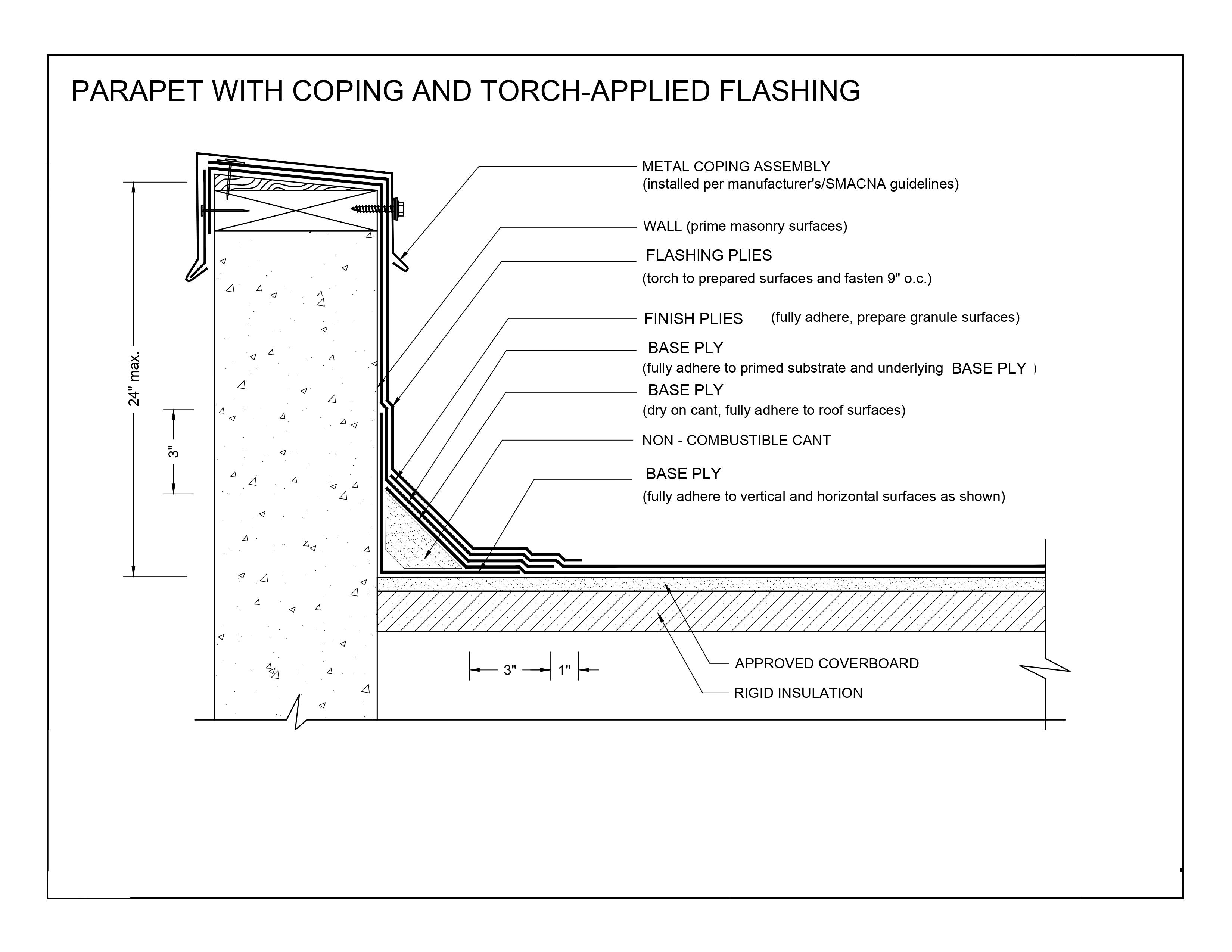
Image courtesy GAF/Siplast
Figure 13. Parapet detailing and transition flashing.
There are other detailing options available for use with modified bitumen systems that provide flexibility depending on the application. Liquid applied flashings are such an option and there are multiple chemistry options on the market such as polymethyl methacrylate (PMMA), polyurethane methacrylate (PUMA), and styrene ethylbutlyene styrene (SEBS). These flashings are often applied in multiple layers and may require an embedded fabric between them. Liquid applied flashings can be used for penetrations, parapet transitions, unusual wall formations and at unique details.
Bitumen and modified bitumen roofing systems have multiple options for recover if they do not contain any trapped moisture within the roof assembly. Avoiding a complete tear off allows for a more cost-effective way to extend the life of the existing roof. Liquid applied coatings can extend the life of a roof system. Liquid applied membranes allow for greater flexibility during installation and are especially adept in recover situations. These coatings and membranes can be made of PMMA, PUMA, acrylic, silicone among others. Liquid applied membranes allow for flexibility both on the full recoat and when recoating and resealing the transition details on the roof. Another option for recover is to apply a fleece-backed single ply membrane such as TPO, PVC or PVC-KEE over the existing roof. These membranes can be adhered to the asphalt roof system in a similar manner as an original cap sheet would be applied over the roof system.
The Hybrid Roof Assembly
This leads to a discussion of the benefits of a hybrid roof assembly. Hybrid roof assemblies offer another way for roof assemblies to contribute to a building's energy efficiency, resiliency, and sustainability goals. Hybrid assemblies combine the benefits of modified-bitumen roof systems with those of single ply roof systems. This intentional combination of materials aims to increase the robustness of the assembly, including UV protection, resistance to ponding water, ease of repair, and resistance to certain chemicals. Hybrid roof assemblies are the latest roofing trend aimed at meeting the demands of modern roofs.
What is a hybrid roof assembly?
A hybrid roof assembly is where two roofing membranes, composed of different materials and product technologies, are used in one single roof system. One type of hybrid assembly consists of a modified bitumen base layer with a cap layer of a thermoplastic single-ply membrane, such as Thermoplastic Polyolefin (TPO) or Polyvinyl Chloride (PVC) or PVC-KEE. Each component of the roof system is chosen for its strengths, and together, the system combines the best of all the technologies present. A hybrid system such as this has increased robustness, with effectively two plies or more of membrane.
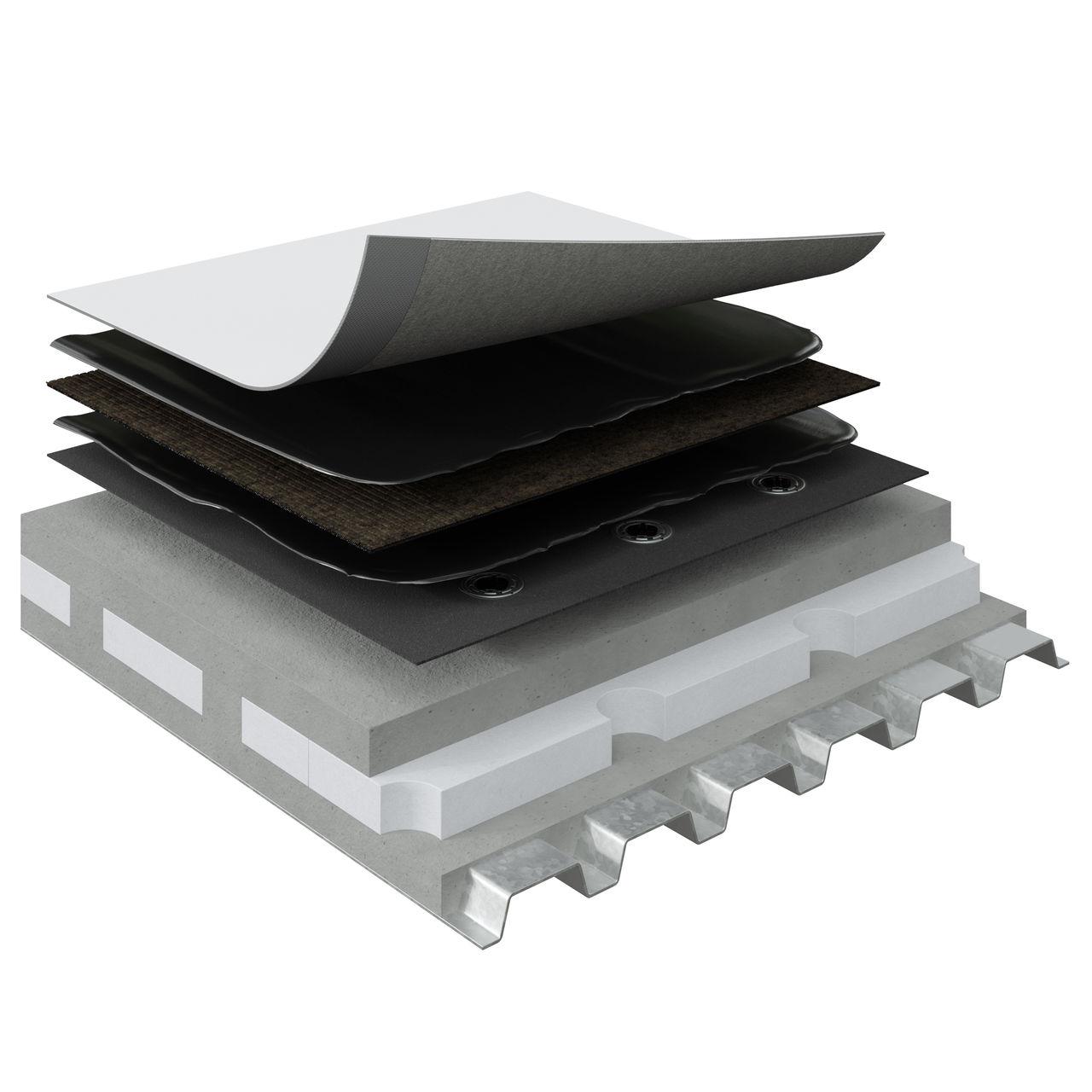
Image courtesy GAF/Siplast
Figure 14. Diagram of a hybrid roof assembly combining an asphaltic base sheet covered by a single-ply membrane.
The combination of an asphaltic base sheet covered by a single-ply membrane increases the overall system thickness and robustness compared to a traditional single-ply system. It provides additional redundancy and protection against punctures, which can be a concern with single-ply applications. As mentioned previously, asphaltic systems are vulnerable to UV exposure without surfacing. They also have minimal resistance to ponding water and certain chemical contaminants; these material shortcomings can be overcome with the addition of a single-ply membrane. If this is a priority for a project, a higher SRI value can be achieved using a single-ply membrane with both high new and aged SRI values than can sometimes be found with modified bitumen cap sheets. When higher SRI value options are chosen, the single-ply membranes placed as a cap layer over bitumen systems can decrease the roof surface temperatures and potentially help reduce the heat island effect of the building. PVC and PVC-KEE (Ketone Ethylene Ester) membranes may also provide protection where exposure to chemicals is a concern, and they generally hold up well in ponding water conditions. Therefore, the combined attributes of bitumen systems and single-ply membranes complement each other, providing a durable, efficient, and redundant roof system.
Common hybrid roof applications
Hybrid roof assemblies can be a logical choice for data centers, education facilities, and hospitals due to their strong protection against leaks and multi-ply system redundancy. The redundancy of the second layer of membrane in the form of an asphaltic base sheet provides a secondary protection against leaks if the single-ply membrane is breached.
Additionally, the reflective, UV stable single-ply membrane can provide a cap sheet that is more durable against certain environmental situations such as specific chemicals that is necessary for specific projects. The addition of a reflective membrane over a dark-colored asphaltic membrane can greatly increase the Solar Reflectance Index (SRI) of the roof surface. SRI is an indicator of the ability of a surface to reflect solar energy back into the atmosphere. In general, roof material surfaces with a higher SRI will be cooler than a surface with a lower SRI under the same solar energy exposure. A lower roof surface temperature can result in less heat being absorbed into the building interior during the summer months, thus reducing building cooling loads.
Hybrid roof installation advantages and considerations
Hybrid systems are not confined to new construction. A key benefit of a hybrid roof assembly occurs in retrofit or recover scenarios where there is an existing-modified bitumen or built-up roof (BUR) that is in overall fair condition and with minimal underlying moisture present. A single-ply membrane can be installed on top of the existing roof system without an expensive and disruptive tear-off of the existing assembly. The addition of the single-ply membrane adds reflectivity to the existing darker colored membrane and increases the service life of the roof assembly due to the additional layer of UV and weather protection. Additionally, the single-ply membrane can be installed with low VOC options that have minimum odor and noise disturbance if construction takes place while the building is occupied. This can include mechanical attachment, induction welding or adhesives.
Whether it is a new roof or a recover of an existing roof, there must be something separating the two materials. This is due to the chemical incompatibility of the single-ply membrane and the modified bitumen. In both scenarios, the easiest way to separate the materials is to use a fleece-backed membrane where the factory-applied fleece backing acts as the separator. In re-roof applications, a coverboard or polymat can be used as a separator with a smooth backed membrane. Any type of attachment method can be used provided it meets the other requirements for the project.
Demonstrable benefits support the marriage of new and old technology
The possibility of combining the best aspects of two different roofing technologies makes a hybrid roof assembly worth the hype. Putting bitumen systems together with a single-ply membrane provides the best aspects of each for the roof. The single-ply membrane integrates a reflective surface for improved energy efficiency, and increased protection against chemical exposure and ponding water, while the asphaltic base increases overall system waterproofing redundancy, durability, and protection. The ability for this method to be used in both new construction and recover scenarios makes a multi-ply hybrid roof an assembly choice that is here to stay.
Summary
In summary, asphaltic or bitumen-based roof assemblies remain an important roofing solution. Modified bitumen systems are simple, practical, versatile, and durable. They provide multiple options for the final assembly look including granules and single-ply membranes as well as the protection required for roofs with overburden.
Modified-bitumen roofs (both APP and SBS) are tear and puncture resistant, have multiple installation options and have choices in scrim to improve specific other properties. As a comparison, built-up roof systems use relatively inexpensive materials compared to modified bitumen, but modified bitumen systems are easier to quality control in the field. All bitumen roof systems are resistant to overall damage from roof traffic, temperature shifts, and weather, and can be considered for many different types of roofing projects.
END NOTES
1Boëda, E.; Connan, J.; Dessort, D. (March 1996). "Bitumen as a hafting material on Middle Palaeolithic artefacts". Nature. 380 (6572): 336–338. doi:10.1038/380336a0.
2McIntosh, Jane. The Ancient Indus Valley. p. 57
3“Great Bath". Britannica. Retrieved 7 March 2024. .
4Abraham, Herbert (1938). Asphalts and Allied Substances: Their Occurrence, Modes of Production, Uses in the Arts, and Methods of Testing (4th ed.). New York: D. Van Nostrand Co., Inc. Full text at Internet Archive (archive.org)
5Roofing Contractors Association of British Columbia. “Template: ROOFTOP EQUIPMENT & WALKWAYS (BUR).” Web. 4 April. 2022.
Andrea Wagner Watts is the Building Science Education Manager for GAF, engaging with industry professionals providing guidance, technical support and education for building enclosure assemblies.
Asphaltic-based low-slope roofing is one of the oldest low-slope roofing technologies; appropriately, it remains a leader in construction segments such as healthcare, education, hospitality, and mixed use. Asphaltic-based roof systems are durable, have a long history of proven performance, and their redundancy provides owners peace of mind. The benefits of asphaltic-based roof systems include durability and redundancy. When used in hybrid systems that combine modified plies with a single-ply cap sheet, the result is a roof system that offers the best of both technologies.
A Short History of Low-Slope Asphaltic Roofing
All asphaltic roof systems start with the same base raw material. The terms bitumen and asphalt are often used interchangeably within the construction industry: asphalt is the most common reference in the U.S., while bitumen is the preferred term internationally. Bitumen is an immensely viscous material that, depending on its exact composition, can be a sticky, black liquid or an apparently solid mass. Bitumen can be found naturally or it can be a by-product from refining crude oil. Pitch Lake in Trinidad has the world’s largest known deposit of natural bitumen, estimated to contain at least 10 million tons of material.

Photo courtesy GAF/Siplast
Natural bitumen at Pitch Lake in Trinidad.
The long history of people and bitumen
The qualities of bitumen have been known and used for human construction projects since ancient times. The earliest estimated use of bitumen dates back 40,000 years to the paleolithic period, where bitumen was used to adhere handles onto primitive stone tools.1 The use of natural bitumen for waterproofing, as well as an adhesive, dates at least to the fifth millennium BC, where it was used in crop storage baskets discovered in Mehrgarh, from the Indus Valley civilization.2 By the third millennium BC, refined rock asphalt was in use throughout the region of present-day India and was used to waterproof the Great Bath in Mohenjo-daro.3 In the ancient Near East, the Sumerians used natural bitumen deposits for mortar between bricks and stones, to adhere parts of carvings into place, and for ship caulking and waterproofing.4
Bitumen in modern times
Documentation of modern low-slope roofs using layers of bitumen and ply sheets to provide waterproofing goes back to at least the 1890s. Multi-layer asphaltic or bitumen roof systems remained the dominant roof assembly of choice until the 1970s and they have continued to endure due to their exceptional hardiness and multiple layers of protection. However, by 2022, asphaltic systems had fallen in popularity: making up about 20 percent of the commercial roofing market. Despite this decline, bitumen or asphaltic roofs are still relied upon today for projects due to their remarkable durability. The redundancy achieved by multiple layers of bitumen provides resilient protection from damage due to heavy foot traffic and during storms and wind events. Bitumen systems can be elastomeric, have built-in puncture resistance, and are compatible with a variety of substrates and conditions. Additionally, bitumen roof systems create an effective, simple, and practical water control system. If the top layer is damaged, the layers below will continue to protect the building from water intrusion.
Not only is a bitumen roof system a time-tested technology with proven performance and redundancy, but modern advances have increased installation options, surfacing variety, and detailing and repair advantages.
Meet the Family – Types of Low-Slope Asphaltic Roofing
BUR
The original asphaltic roof system for low-slope roofs is referred to as a built-up roof (BUR) system. BUR roof systems have been used for more than one hundred years in the U.S. BUR roof systems are made up of multiple, alternating layers of reinforcing ply sheets and asphalt, providing multiple layers of protection. BUR systems remain in use today because of the excellent protection they provide.
The core of the BUR system is assembled using a shingling system of alternating layers of plies and liquid oxidized asphalt, embedding each ply into a layer of asphalt and ensuring substantial overlap with the previous ply. Historically, rags, paper, or asbestos were used as the reinforcing plies. Thanks to technology advancements, the plies are generally asphalt-impregnated fiberglass felts, fabrics or mats. Fiberglass felt plies or glass plies contribute to the fire-resistance of the roof system.

Photo courtesy GAF/Siplast
Installation of a BUR roof system.

Image courtesy GAF/Siplast
Figure 3. Diagram of layers in a BUR roof system.
Installers traditionally rely on hot mopping of the asphalt requiring kettles, either placed on the roof or on the ground onsite. Advances in manufacturing have created alternative options such as cold-applied adhesive solutions instead of hot mopping asphalt and kettles. Cold-applied adhesives have temperature installation limits, but they can reduce the challenge of keeping an asphalt kettle hot enough during cooler weather.
The layering process is repeated on the roof with the application of asphalt or cold-applied adhesive, followed by the installation of additional plies until the desired number of plies is achieved. The multiple plies, when saturated in asphalt or cold-applied adhesive, create a barrier that provides additional resistance to water intrusion. The complete roof assembly typically ranges from 2 to 5 plies. This installation method can be labor intensive and requires quality workmanship to be successful. The system is then surfaced with either a mineral-surfaced cap sheet or with a flood coat of asphalt and mineral aggregate or gravel, a liquid applied coating, or, historically, slag.
Benefits of BUR
Built up roofing owes its popularity to the number of benefits it provides. It is a time-tested technology, with more than 100 years of history. These roofs provide many layers of protection, so that if the top layer becomes damaged, the additional layers below will continue to protect the building from water intrusion. BUR is, by design, redundant. BUR system materials remain relatively inexpensive and offer excellent fire resistance. However, BUR installation is more labor intensive than other low-slope roofing choices.
Because of its proven performance and resilience, BUR systems may be eligible for guarantees or warranties exceeding 20 years, depending on the materials used and the system installed. Modern BUR manufacturers also offer reflective cap sheets or granules. These cap sheets are available to help reflect the sun's rays away from the building, which can assist in maintaining internal temperatures.
Developments in roofing after World War II
Roofing, and the construction industry in general, experienced dramatic shifts in materials after World War II. This shift in both technology and availability changed how buildings were built. Roofs became noticeably flatter as lightweight steel construction supplanted the use of concrete and wood framing. As roofs became flatter, more equipment moved to the roof and the amount of foot traffic on the roof increased. The greater use of steel created buildings that flexed and moved more, requiring materials capable of accommodating the movement without failures. Additionally, the efforts from the war produced new types of polymers that were used in automotive and aeronautic applications that also found their way into roofing.
At the same time, the quality of BUR materials dropped dramatically. As a result, the industry developed a “new” bitumen that utilized polymers added to a bituminous base. These modified bitumen blends were used to create new membranes with the redundancy and durability of traditional BUR, but with additional properties from the rubber or plastic modifiers. The new formulas were able to accommodate the movement and have increased durability as the modified bitumen had a higher softening point and more elongation.
Creating modified bitumen blends
Modified bitumen used in roof materials is produced by blending together raw bitumen, filler, and polymer which are then layered with reinforcement to create a modified bitumen roll. Not all bitumen blends are the same. The quality of the final material is highly dependent on the quality of raw materials used, the manufacturer’s formulation, and the blending process. It is critical to be aware that there are different asphalt sources of varying quality and different types and quantities of polymer and fillers that can alter the final properties and durability of a material.
Bitumen forms the foundation of a good quality blend. Not all bitumen is receptive to modification and blending with the other components of the final material. Additionally, lower quality bitumen results in poor performance and premature aging of the entire product. Therefore, a manufacturer’s asphalt source is extremely important.
While fillers are the lowest cost material used, they have important roles to play in the final formulation. Filler is the material that stabilizes the blend and provides the finished product with many of its engineered properties. Fillers are typically mineral-based. They are used to stabilize the formula, bolster fire resistance, and increase ultra-violet light (UV) and weathering resistance. For example, the addition of carbon and graphite can increase fire performance. Limestone and basalt can decrease the cost of the formula and aid in absorbing excess oil. Waxes and tackifying oils are added to increase self-adhesive properties of the formula. Most modified bitumen formulas contain between 25 percent and 35 percent filler. If a formulation has too much filler, more than 35 percent in filler additives, the final blend degrades.
Polymers are the most expensive element of a modified bitumen blend. There are three common polymers used to modify asphalt today: SBS (styrene butadiene styrene), APP (atactic polypropylene), and IPP (isotactic polypropylene). We’re going to focus on the two most common polymer blends currently used in roofing: APP and SBS.
APP
APP is short for Atactic Polypropylene. It is a plastic-type polymer that imparts rigidity to the final material. A good APP-modified bitumen material will typically have 20-30 percent APP in the final formulation. APP modified bitumen materials have a higher softening temperature and are harder or have a higher durometer than SBS modified bitumens.
SBS
SBS, or Styrene-Butadiene-Styrene, is a rubber-type polymer that comprises roughly 10 to 13 percent of the total blend. An SBS-modified bitumen blend is a softer, more malleable final product than an APP blend. This additive allows the blended SBS to achieve greater elongation than other asphaltic systems.
Reinforcing scrim
Reinforcing scrim acts as a carrier for the modified bitumen. The scrim is embedded within the sheet and provides dimensional stability for the roll, improves fastener retention, and increases puncture resistance. There are three primary types of reinforcing scrim: fiberglass, polyester and composite or hybrid mats.
The type of scrim or reinforcement will influence different properties of the material. Fiberglass reinforcement is more fire resistant and provides dimensional stability while polyester reinforcement is more puncture resistant and has better elongation and tear resistance.
The modified bitumen sheets can be specified based on the type of reinforcement using different ASTM specification numbers. In the case of SBS rolls, ASTM D 6163 denotes a fiberglass reinforcement, ASTM D 6164 is for polyester reinforcement and ASTM E6162 is the specification for SBS sheets with a combination or hybrid reinforcement. In addition to specifying the ASTM specification number, it is valuable to also reference the Type and Grade of the material. The Type further indicates the mass and physical properties of the sheet: Type II materials have a larger net mass, peak load, and tear strength than Type I. The Grade indicates the surfacing of the sheet, either G for granule or S for smooth.
Summary
All of the components of a modified bitumen sheet - the bitumen, filler, and polymer - come together through a blending process. Adding a polymer changes the dispersal and consistency of all the products throughout the blend, making the blending protocol incredibly important. The blending time and temperature can greatly affect the dispersal and consistency of the filler and polymer within the bitumen matrix, changing the properties of the final material. The modified bitumen is then extruded into rolls with the reinforcement of choice to make the final roll used on a building.
Installation and Application Options
Commercial asphalt roofing systems are multi-ply systems consisting of two or more waterproofing layers. This redundancy provides building owners with durable protection for their building. Beyond the material properties, asphaltic or bitumen roof systems are adaptable and can be installed using various methods with multiple detailing options and surfacing varieties.

Image courtesy GAF/Siplast
Figure 5. Installed image of a modified bitumen system.
Installation options
Modified bitumen systems consist of at least two layers: a base sheet and a cap sheet. An additional base sheet may be mechanically attached to the roof deck in cases where the application requires. Both SBS and APP sheets can be torch applied, cold applied or self-adhered. However, APP is most commonly installed by torching due to the high temperatures required to get the material to flux or melt; cold-applied and self-adhered options for APP may not be readily available. Additionally, SBS has the ability to be hot mopped. This list of installation methods may not be exhaustive of all options available on the market as the industry is always changing and new products are introduced and discontinued (see Figure 5). It is not necessary for both layers of a modified bitumen system to be installed in the same manner.

Image courtesy GAF/Siplast
Figure 6. Installation options for modified bitumen systems.
Both APP and SBS modified rolls can be installed using a torch method. Torch application uses an open-flamed torch to heat the back side of the sheet to flux, or the point of softening the modified bitumen so that it will adhere to the substrate below as it cools. It is important to note that APP fluxes at a much higher temperature than SBS, so crews who are used to torching one style of sheet may initially struggle to torch the other style. Because of the lower temperatures at which SBS membranes soften, the seams of the membrane can be sealed using a welder similar to the method to seal seams of a single-ply membrane.

Photo courtesy GAF/Siplast
Installation of a modified bitumen roll using torch application.

Photo courtesy GAF/Siplast
Sealing the seams of an SBS membrane with a welder, similar to the method used to seal seams of a single-ply membrane.
The other hot method for applying asphaltic roof systems is called hot-mopping. This is the method used for BUR roofing but can be used for SBS systems as well. Hot mopping involves melting blocks of asphalt in a large kettle and spreading the melted asphalt on the roof with mops. In addition to being an adhesive, this method can provide additional redundancy to the SBS system as you have a thicker sheet that already provides waterproofing being embedded in a layer of asphalt which will act as its own waterproofing component.
SBS can also be installed using a cold-applied adhesive. For this method, a solvent-based or solvent-free liquid adhesive is applied to the roof surface or previously laid membrane and spread evenly using a tool such as a notched squeegee. The modified bitumen sheet is then rolled into the adhesive. This option is good for when asphaltic fumes, open flames, and kettles that can accompany hot-applied roofing are not permissible.

Photo courtesy GAF/Siplast
SBS modified bitumen rolls installed using a cold-applied adhesive.
Finally, self-adhered modified bitumen membranes are available, both for SBS and a few APP systems. A self-adhered membrane is installed by removing a release film off the back of an already rolled out membrane. The membrane is then rolled to ensure it adheres to the substrate below. This method can increase the speed of installation over other traditional methods. Self-adhered membranes do not produce unpleasant odors, fumes, or heat, an important factor installing on an occupied building.
Surfacing variety
Asphaltic assemblies need a top surface to provide protection from UV, excessive surface temperatures, to provide fire protection, and to provide puncture and roof traffic resistance. There are many options available to designers and owners depending on the desired aesthetic and roof use. These options include a flood coat of asphalt and mineral aggregate or gravel, a mineral-surfaced cap sheet, an elastomeric coating, or even a traditional fleeceback single-ply membrane.
The traditional method to complete a bitumen roof such as BUR is a flood coating of asphalt with embedded gravel. The gravel layer protects from UV degradation, roof traffic, storm damage, and wind debris. For this option to be successful, the roof structure below must be designed and built to accommodate the anticipated additional weight of the gravel.
One of the most common ways to surface an asphaltic roof assembly is with a mineral surfaced or granulated cap sheet. This sheet employs a modified sheet that is thicker and has the granules already factory applied to the sheet. This cap sheet provides UV protection and surfacing to protect from traffic. Bright white granules with a high solar reflective index (SRI) for projects that need to meet specific reflectivity requirements are also available.

Photo courtesy GAF/Siplast
Application of a cap sheet.
Some modified bitumen assemblies can also be surfaced with a coating. The coating can be a squeegee-applied glaze coat of Type 1 asphalt, an asphaltic-based clay emulsion coating or any number of elastomeric coatings such as silicone, acrylics or urethanes. The elastomeric coatings may not be as strong against debris or roof traffic, but there are multiple options with high SRI values.
Finally, a fleece-backed thermoplastic membrane can be the surfacing or cap for a modified system. These membranes can have high SRI values, are resistant to ponding water, are easy to repair and maintain, and may offer more resistance to certain chemicals. This type of “hybrid” system provides the redundancy of a modified system with the benefits of a thermoplastic membrane.
Detailing and repair
As with the vast majority of roof systems, transition details can be done with materials of a technology similar to the roof material itself. For example, an SBS system can be specified to use an SBS flashing sheet with a granule surfacing to match the rest of the roof or an unsurfaced flashing sheet. For parapets (Figure 13), transition flashing typically uses 3-4 layers at the 90-degree bend, typically uses a cant strip, and has at least 2 layers up the vertical wall. Additionally, there are asphaltic backed foil surfaced flashing options available. The foil surfaced flashing option, when used on parapets and edge details, can direct heat away from the wall edge, potentially reducing the amount of movement at the roof-to-wall interface.

Image courtesy GAF/Siplast
Figure 13. Parapet detailing and transition flashing.
There are other detailing options available for use with modified bitumen systems that provide flexibility depending on the application. Liquid applied flashings are such an option and there are multiple chemistry options on the market such as polymethyl methacrylate (PMMA), polyurethane methacrylate (PUMA), and styrene ethylbutlyene styrene (SEBS). These flashings are often applied in multiple layers and may require an embedded fabric between them. Liquid applied flashings can be used for penetrations, parapet transitions, unusual wall formations and at unique details.
Bitumen and modified bitumen roofing systems have multiple options for recover if they do not contain any trapped moisture within the roof assembly. Avoiding a complete tear off allows for a more cost-effective way to extend the life of the existing roof. Liquid applied coatings can extend the life of a roof system. Liquid applied membranes allow for greater flexibility during installation and are especially adept in recover situations. These coatings and membranes can be made of PMMA, PUMA, acrylic, silicone among others. Liquid applied membranes allow for flexibility both on the full recoat and when recoating and resealing the transition details on the roof. Another option for recover is to apply a fleece-backed single ply membrane such as TPO, PVC or PVC-KEE over the existing roof. These membranes can be adhered to the asphalt roof system in a similar manner as an original cap sheet would be applied over the roof system.
The Hybrid Roof Assembly
This leads to a discussion of the benefits of a hybrid roof assembly. Hybrid roof assemblies offer another way for roof assemblies to contribute to a building's energy efficiency, resiliency, and sustainability goals. Hybrid assemblies combine the benefits of modified-bitumen roof systems with those of single ply roof systems. This intentional combination of materials aims to increase the robustness of the assembly, including UV protection, resistance to ponding water, ease of repair, and resistance to certain chemicals. Hybrid roof assemblies are the latest roofing trend aimed at meeting the demands of modern roofs.
What is a hybrid roof assembly?
A hybrid roof assembly is where two roofing membranes, composed of different materials and product technologies, are used in one single roof system. One type of hybrid assembly consists of a modified bitumen base layer with a cap layer of a thermoplastic single-ply membrane, such as Thermoplastic Polyolefin (TPO) or Polyvinyl Chloride (PVC) or PVC-KEE. Each component of the roof system is chosen for its strengths, and together, the system combines the best of all the technologies present. A hybrid system such as this has increased robustness, with effectively two plies or more of membrane.

Image courtesy GAF/Siplast
Figure 14. Diagram of a hybrid roof assembly combining an asphaltic base sheet covered by a single-ply membrane.
The combination of an asphaltic base sheet covered by a single-ply membrane increases the overall system thickness and robustness compared to a traditional single-ply system. It provides additional redundancy and protection against punctures, which can be a concern with single-ply applications. As mentioned previously, asphaltic systems are vulnerable to UV exposure without surfacing. They also have minimal resistance to ponding water and certain chemical contaminants; these material shortcomings can be overcome with the addition of a single-ply membrane. If this is a priority for a project, a higher SRI value can be achieved using a single-ply membrane with both high new and aged SRI values than can sometimes be found with modified bitumen cap sheets. When higher SRI value options are chosen, the single-ply membranes placed as a cap layer over bitumen systems can decrease the roof surface temperatures and potentially help reduce the heat island effect of the building. PVC and PVC-KEE (Ketone Ethylene Ester) membranes may also provide protection where exposure to chemicals is a concern, and they generally hold up well in ponding water conditions. Therefore, the combined attributes of bitumen systems and single-ply membranes complement each other, providing a durable, efficient, and redundant roof system.
Common hybrid roof applications
Hybrid roof assemblies can be a logical choice for data centers, education facilities, and hospitals due to their strong protection against leaks and multi-ply system redundancy. The redundancy of the second layer of membrane in the form of an asphaltic base sheet provides a secondary protection against leaks if the single-ply membrane is breached.
Additionally, the reflective, UV stable single-ply membrane can provide a cap sheet that is more durable against certain environmental situations such as specific chemicals that is necessary for specific projects. The addition of a reflective membrane over a dark-colored asphaltic membrane can greatly increase the Solar Reflectance Index (SRI) of the roof surface. SRI is an indicator of the ability of a surface to reflect solar energy back into the atmosphere. In general, roof material surfaces with a higher SRI will be cooler than a surface with a lower SRI under the same solar energy exposure. A lower roof surface temperature can result in less heat being absorbed into the building interior during the summer months, thus reducing building cooling loads.
Hybrid roof installation advantages and considerations
Hybrid systems are not confined to new construction. A key benefit of a hybrid roof assembly occurs in retrofit or recover scenarios where there is an existing-modified bitumen or built-up roof (BUR) that is in overall fair condition and with minimal underlying moisture present. A single-ply membrane can be installed on top of the existing roof system without an expensive and disruptive tear-off of the existing assembly. The addition of the single-ply membrane adds reflectivity to the existing darker colored membrane and increases the service life of the roof assembly due to the additional layer of UV and weather protection. Additionally, the single-ply membrane can be installed with low VOC options that have minimum odor and noise disturbance if construction takes place while the building is occupied. This can include mechanical attachment, induction welding or adhesives.
Whether it is a new roof or a recover of an existing roof, there must be something separating the two materials. This is due to the chemical incompatibility of the single-ply membrane and the modified bitumen. In both scenarios, the easiest way to separate the materials is to use a fleece-backed membrane where the factory-applied fleece backing acts as the separator. In re-roof applications, a coverboard or polymat can be used as a separator with a smooth backed membrane. Any type of attachment method can be used provided it meets the other requirements for the project.
Demonstrable benefits support the marriage of new and old technology
The possibility of combining the best aspects of two different roofing technologies makes a hybrid roof assembly worth the hype. Putting bitumen systems together with a single-ply membrane provides the best aspects of each for the roof. The single-ply membrane integrates a reflective surface for improved energy efficiency, and increased protection against chemical exposure and ponding water, while the asphaltic base increases overall system waterproofing redundancy, durability, and protection. The ability for this method to be used in both new construction and recover scenarios makes a multi-ply hybrid roof an assembly choice that is here to stay.
Summary
In summary, asphaltic or bitumen-based roof assemblies remain an important roofing solution. Modified bitumen systems are simple, practical, versatile, and durable. They provide multiple options for the final assembly look including granules and single-ply membranes as well as the protection required for roofs with overburden.
Modified-bitumen roofs (both APP and SBS) are tear and puncture resistant, have multiple installation options and have choices in scrim to improve specific other properties. As a comparison, built-up roof systems use relatively inexpensive materials compared to modified bitumen, but modified bitumen systems are easier to quality control in the field. All bitumen roof systems are resistant to overall damage from roof traffic, temperature shifts, and weather, and can be considered for many different types of roofing projects.
END NOTES
1Boëda, E.; Connan, J.; Dessort, D. (March 1996). "Bitumen as a hafting material on Middle Palaeolithic artefacts". Nature. 380 (6572): 336–338. doi:10.1038/380336a0.
2McIntosh, Jane. The Ancient Indus Valley. p. 57
3“Great Bath". Britannica. Retrieved 7 March 2024. .
4Abraham, Herbert (1938). Asphalts and Allied Substances: Their Occurrence, Modes of Production, Uses in the Arts, and Methods of Testing (4th ed.). New York: D. Van Nostrand Co., Inc. Full text at Internet Archive (archive.org)
5Roofing Contractors Association of British Columbia. “Template: ROOFTOP EQUIPMENT & WALKWAYS (BUR).” Web. 4 April. 2022.
Andrea Wagner Watts is the Building Science Education Manager for GAF, engaging with industry professionals providing guidance, technical support and education for building enclosure assemblies.













